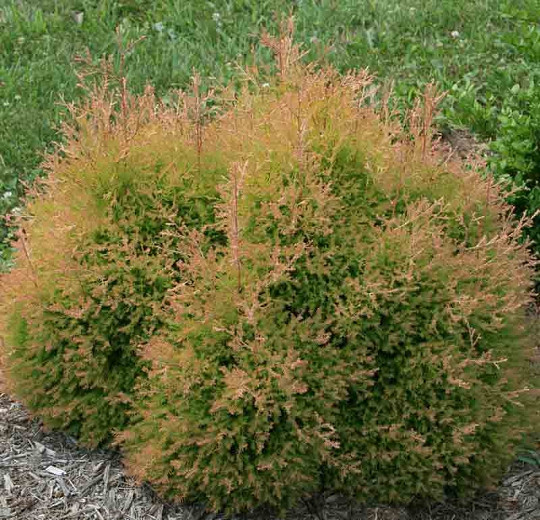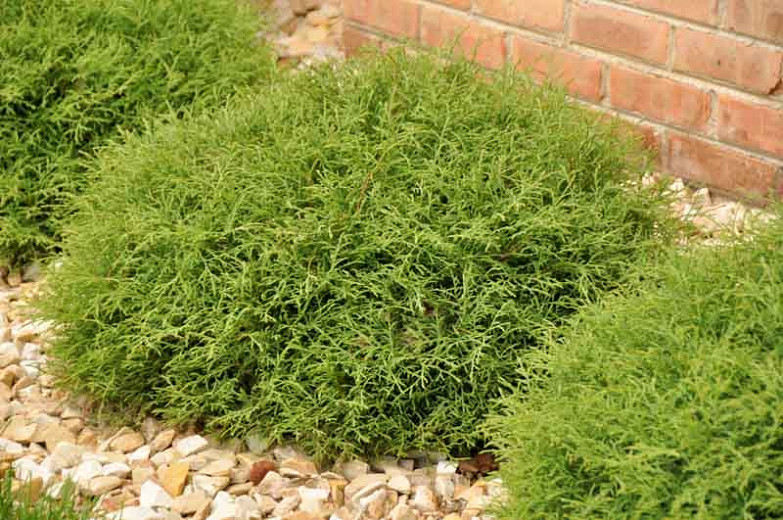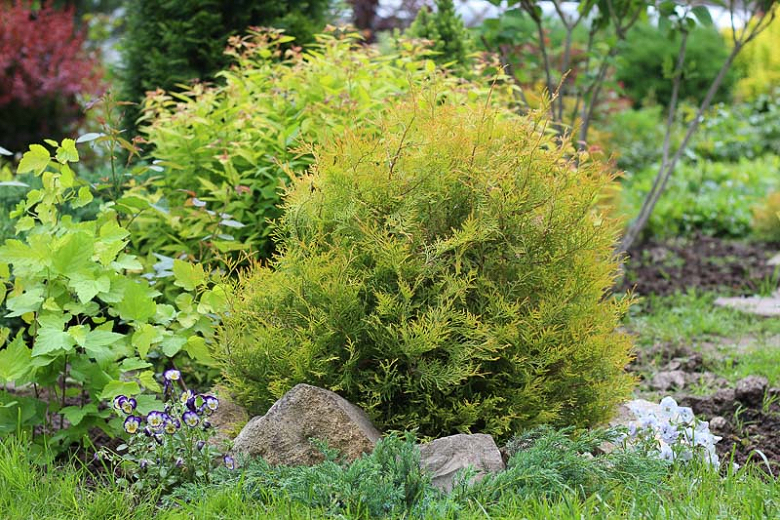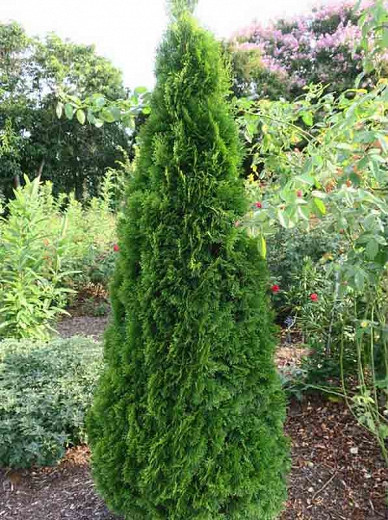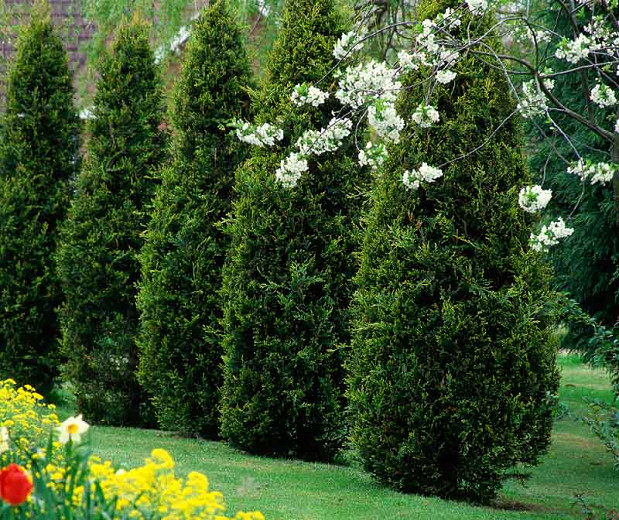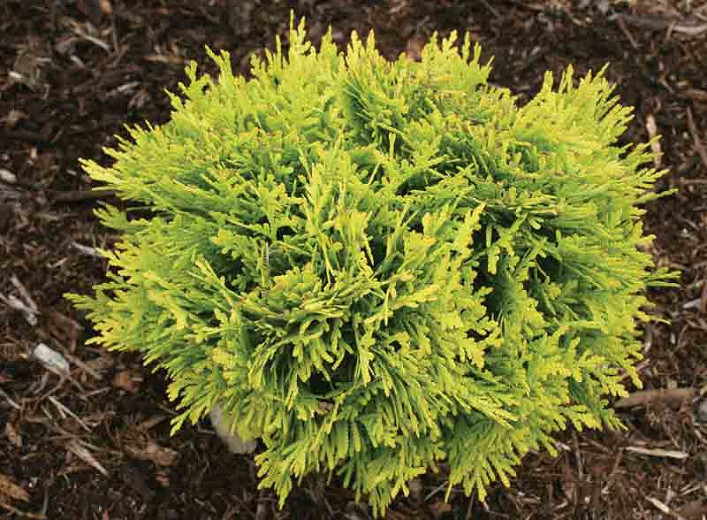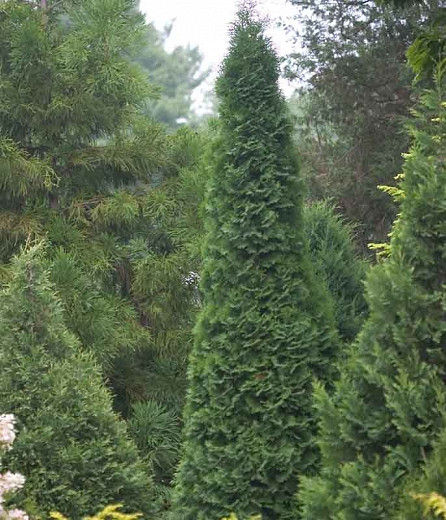Thuja occidentalis Fire Chief™ (American Arborvitae)
Thuja occidentalis Fire Chief™ (American Arborvitae) is a dwarf, evergreen shrub of rounded habit with dense sprays of feathery, bright gold foliage in spring, turning sage-green and topped with red tips in the fall. Slow-growing, this distinctive Thuja is perfect for foundation plantings, rock gardens, as low hedges, or in borders. Its petite size makes it ideal for containers and small gardens too. This sport of highly popular Thuja occidentalis ‘Rheingold’ is regarded by many as a superior cultivar thanks to its better color throughout the season. It is also less prone to splitting under a load of snow or ice in winter.
Thuja occidentalis Fire Chief™ (American Arborvitae) is a dwarf, evergreen shrub of rounded habit with dense sprays of feathery, bright gold foliage in spring, turning sage-green and topped with red tips in the fall. Slow-growing, this distinctive Thuja is perfect for foundation plantings, rock gardens, as low hedges, or in borders. Its petite size makes it ideal for containers and small gardens too. This sport of highly popular Thuja occidentalis 'Rheingold' is regarded by many as a superior cultivar thanks to its better color throughout the season. It is also less prone to splitting under a load of snow or ice in winter.
- Grows up to 3-4 ft. tall and wide (90-120 cm).
- A full sun lover, this plant is easily grown in average, moist, well-drained soils. Usually appreciates some light afternoon shade in hot summer climates. Bear in mind that foliage density loosens up in too much shade. Tolerates a wide range of soils. Thrives in humid weather with regular rainfalls. Intolerant of dry conditions. Protect from drying winds especially when young.
- Perfect as a specimen plant or for shrub borders, hedges, and screens, as foundation plants. Suitable for rock gardens. Performs well in wet areas of the garden and near swamps and bogs. Attractive in containers too!
- No serious insect or disease problems. May be affected by spider mites, bagworms, or coryneum canker.
- Low maintenance, American arborvitae tolerates shearing well for a more tailored column. Prune in early spring before the onset of new growth. Provide a generous root zone mulch
- Propagate by semi-hardwood cuttings
- Native to Northeastern United States, Mid-Atlantic United States, Southeastern United States, North-Central United States, Central United States, Canada
Requirements
| Hardiness | 5 – 9 |
|---|---|
| Heat Zones | 1 – 7 |
| Climate Zones | 1, 1A, 1B, 2, 2A, 2B, 3, 3A, 3B, 4, 5, 6, 7, 8, 9, 15, 16, 17, 21, 22, 23, 24, A2, A3, H1, H2 |
| Plant Type | Conifers, Shrubs |
| Plant Family | Thuja |
| Exposure | Full Sun |
| Season of Interest | Spring (Early,Mid,Late)Summer (Early,Mid,Late)FallWinter |
| Height | 3' – 4' (90cm – 120cm) |
| Spread | 3' – 4' (90cm – 120cm) |
| Spacing | 36″ – 48″ (90cm – 120cm) |
| Water Needs | Average |
| Maintenance | Low |
| Soil Type | Chalk, Clay, Loam, Sand |
| Soil pH | Acid, Alkaline, Neutral |
| Soil Drainage | Moist but Well-Drained |
| Characteristics | Showy, Evergreen |
| Attracts | Birds |
| Garden Uses | Beds and Borders, Hedges and Screens, Patio and Containers, Ponds and Streams, Small Gardens |
| Garden Styles | City and Courtyard, Gravel and Rock Garden, Informal and Cottage, Traditional Garden |
